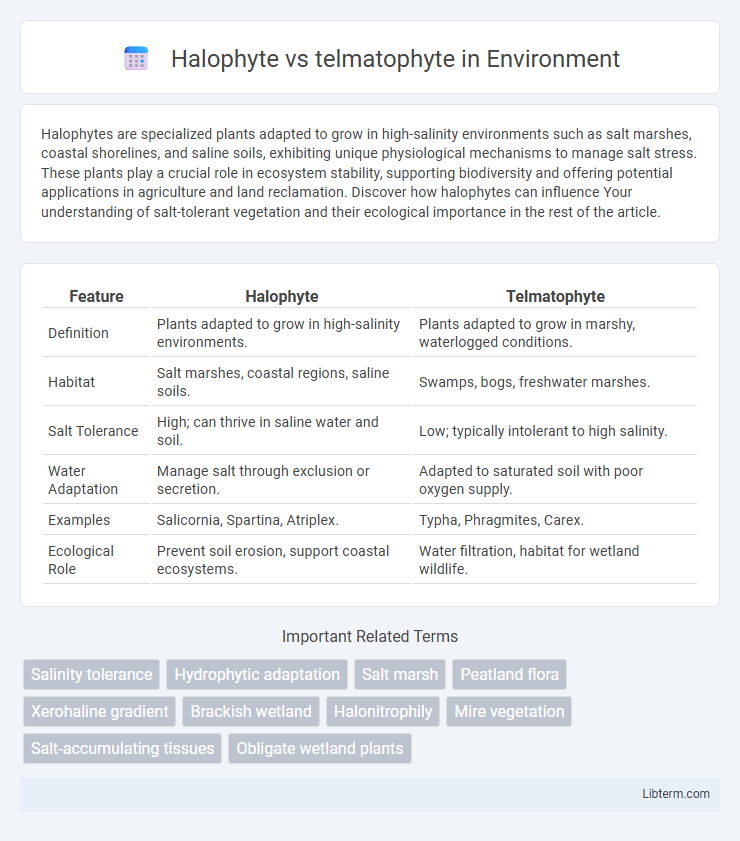Halophytes are specialized plants adapted to grow in high-salinity environments such as salt marshes, coastal shorelines, and saline soils, exhibiting unique physiological mechanisms to manage salt stress. These plants play a crucial role in ecosystem stability, supporting biodiversity and offering potential applications in agriculture and land reclamation. Discover how halophytes can influence Your understanding of salt-tolerant vegetation and their ecological importance in the rest of the article.
Table of Comparison
| Feature | Halophyte | Telmatophyte |
|---|---|---|
| Definition | Plants adapted to grow in high-salinity environments. | Plants adapted to grow in marshy, waterlogged conditions. |
| Habitat | Salt marshes, coastal regions, saline soils. | Swamps, bogs, freshwater marshes. |
| Salt Tolerance | High; can thrive in saline water and soil. | Low; typically intolerant to high salinity. |
| Water Adaptation | Manage salt through exclusion or secretion. | Adapted to saturated soil with poor oxygen supply. |
| Examples | Salicornia, Spartina, Atriplex. | Typha, Phragmites, Carex. |
| Ecological Role | Prevent soil erosion, support coastal ecosystems. | Water filtration, habitat for wetland wildlife. |
Introduction to Halophytes and Telmatophytes
Halophytes are salt-tolerant plants adapted to thrive in saline environments such as salt marshes and coastal regions, exhibiting specialized physiological mechanisms like salt excretion and succulence. Telmatophytes, on the other hand, are moisture-loving plants primarily found in wetlands and marshy areas, adapted to saturated soils with varying oxygen availability. Both plant types demonstrate unique adaptations that enable survival in distinct challenging habitats characterized by salinity for halophytes and waterlogged conditions for telmatophytes.
Definition and Key Characteristics
Halophytes are salt-tolerant plants adapted to saline environments such as coastal marshes and salt flats, characterized by specialized salt-excreting glands or succulent leaves to manage high salinity. Telmatophytes thrive in wet, marshy, or swampy habitats, exhibiting adaptations like aerenchyma tissue for oxygen transport in waterlogged soils and extensive root systems for stability. Both plant types demonstrate unique physiological and morphological traits enabling survival in extreme moisture and salinity conditions.
Habitat and Environmental Adaptations
Halophytes thrive in saline environments such as salt marshes, coastal regions, and salt flats, exhibiting adaptations like salt excretion glands and succulent leaves to manage high salt concentrations. Telmatophytes, or marsh plants, inhabit freshwater wetlands and swamps, adapting to waterlogged, low-oxygen soils through features like aerenchyma tissue for gas exchange and shallow root systems. These distinct habitat preferences drive specialized morphological and physiological adaptations that enable survival under salinity stress in halophytes and anaerobic conditions in telmatophytes.
Morphological Differences
Halophytes exhibit succulent leaves and specialized salt glands for salt excretion, adapting to saline environments, while telmatophytes possess elongated stems and reduced leaf structures suited for waterlogged or marshy habitats. Halophytes often show thick cuticles and robust root systems to manage salt uptake, contrasting with the aerenchyma-rich tissues of telmatophytes that facilitate oxygen transport in hypoxic soils. These morphological adaptations enable halophytes to thrive in high-salinity soils and telmatophytes to survive submerged or saturated conditions.
Physiological Mechanisms
Halophytes use specialized salt glands and vacuolar sequestration to manage ion balance and maintain osmotic stability in high salinity environments, ensuring cellular homeostasis and preventing ion toxicity. Telmatophytes, adapted to swampy or waterlogged conditions, rely on aerenchyma formation and enhanced root oxygen transport to cope with hypoxic stress and facilitate nutrient uptake. Both plant types exhibit distinct physiological adaptations that optimize survival under their respective abiotic stress conditions.
Salt Tolerance Strategies
Halophytes employ specialized salt tolerance strategies such as salt gland secretion, ion compartmentalization in vacuoles, and osmotic adjustment through compatible solutes to thrive in high-salinity environments. Telmatophytes, adapted to marshy or waterlogged soils, typically exhibit salt avoidance by rooted preference for low-saline zones and mechanisms to limit salt uptake rather than extensive salt tolerance. Understanding these distinct physiological adaptations helps optimize agricultural practices in saline-prone wetlands and coastal ecosystems.
Ecological Roles and Importance
Halophytes play a critical ecological role by thriving in saline environments, stabilizing coastal and desert ecosystems, and supporting biodiversity through salt-tolerant habitats. Telmatophytes, adapted to wetland and marshy areas, contribute significantly to water purification, carbon sequestration, and providing habitat for aquatic organisms. Both plant groups are essential for maintaining ecological balance in their respective environments, promoting soil health, and supporting diverse wildlife communities.
Distribution and Examples
Halophytes thrive in saline environments such as coastal salt marshes and salt flats, with prominent examples including Spartina alterniflora and Salicornia europaea. Telmatophytes predominantly inhabit freshwater wetlands and marshes, commonly represented by species like Typha latifolia and Phragmites australis. The distribution of halophytes is closely linked to salt-tolerant ecosystems, whereas telmatophytes are found in freshwater or low-salinity habitats.
Adaptation to Climate Change
Halophytes exhibit specialized adaptations such as salt excretion glands and succulence to thrive in saline environments increasingly affected by climate change-induced sea level rise and soil salinization. Telmatophytes, adapted to waterlogged, swampy habitats, possess aerenchyma tissues enabling efficient oxygen transport under fluctuating water regimes exacerbated by altered precipitation patterns. Both plant groups contribute to ecosystem resilience, with halophytes stabilizing coastal zones and telmatophytes maintaining wetland biodiversity amid climatic stressors.
Applications in Agriculture and Restoration
Halophytes, salt-tolerant plants, are crucial for agriculture in saline soils, enhancing crop viability and enabling sustainable farming in salt-affected areas. Telmatophytes, adapted to wetlands and marshes, play a vital role in ecological restoration by stabilizing soil and improving water quality through nutrient filtration. Utilizing halophytes and telmatophytes in targeted agricultural and restoration projects promotes resilience in degraded environments and supports biodiversity conservation.
Halophyte Infographic

 libterm.com
libterm.com